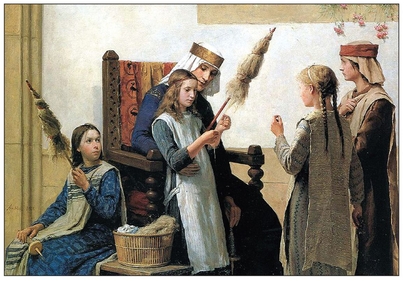CHAPTER FIFTEEN
Literary Textiles – Quotes, Metaphors etc.

Rumplestiltskin by Walter Crane.
Walter Benjamin (1892 – 1940), the German theologist, writer and essayist applies weaving as a metaphor for good writing:
Work on good prose has three steps: a musical stage when it is composed, an architectonic one when it is built, and a textile one when it is woven.
An American writer, Ambrose Bierce, journalist and editor, 1842 – 1914 has an interesting idea about ghosts and how they always appear in shrouds or clothing:
Accounting for the uncommon behavior of ghosts, Heine mentions somebody’s ingenious theory to the effect that they are as much afraid of us as we of them. Not quite, if I may judge from such tables of comparative speed as I am able to compile from memories of my own experience. There is one insuperable obstacle to a belief in ghosts. A ghost never comes naked: he appears either in a winding-sheet or “in his habit as he lived.” To believe in him, then, is to believe that not only have the dead the power to make themselves visible after there is nothing left of them, but that the same power inheres in textile fabrics. Supposing the products of the loom to have this ability, what object would they have in exercising it? And why does not the apparition of a suit of clothes sometimes walk abroad without a ghost in it? These be riddles of significance. They reach away down and get a convulsive grip on the very tap-root of this flourishing faith.
Perhaps the answer to ghosts wearing clothes lies in Grandma’s prayer by Eugene Field:
I pray, that, risen from, the dead,
I may in glory stand
A crown, perhaps upon my head,
But a needle in my hand.
I’ve never learned to sing or play,
So let no harp be mine;
From birth unto my dying day,
Plain sewing’s been my line.
Therefore accustomed to the end
To plying useful stitches,
I’ll be content if asked to mend
The little angels’ breeches.
William Butler Yeats, the great Irish poet (1865 – 1939) is attributed with having put these thoughts into a poem:
I made my song a coat
Covered with embroideries
Out of old mythologies
From heel to throat;
But the fools caught it,
Wore it in the worlds’ eyes
As though they’d wrought it.
Song, let them take it,
For there’s more enterprise
In walking naked.
Shakespeare often used textile imagery in his plays:
O fello, come, the song we had last night.
Mark it Cesario, it is old and plain.
The spinsters, and the knitters in the sun,
And the free maids that weave their thread with bones,
Do use to chant it…
Twelfth Night, Act 2, Scene 4
From the same play a Nineteenth Century author, Ella Rodman Church, in The Home Needle, 1882, has slightly altered a very famous line:
Children seldom achieve greatness, in the way of sewing, unless it is thrust upon them.
Robin Goodfellow, in A Mids um mer Night’s Dream, chances upon the rude mechanicals practising for their performance of Piramus and Thisbe. Robin, overhearing their plans recognises them as ‘hempen homespuns’ which does not reflect well on one of them, Bottom, a weaver and probably a guild member.
Twelfth Night.

Alfred Lord Tennyson’s lonely lady locked in a tower and cursed if she ever tries to leave it took solace in creating woven images from the things she saw in her mirror, the Lady of Shallott.
The enigmatic song, Scarborough Fair, which requires the singer’s lover to make him a shirt without needlework, perhaps she considered felting it instead?
The Lady of Shallot at her loom.

There are a whole spate of wool related sayings:
- No wool is so white that the dyer cannot blacken it. Which is to say that no one is so perfect that nothing can be found that mars their character or reputation
- Wool gathering. Maybe this is related to that sleep that knits up the ravelled sleeve of care? To be distracted from the task in hand. Perhaps it goes back to the time when children were sent out to pick up wool left on fences and in bushes by the sheep and who would get sidetracked by some other interest
- To go for wool and come home shorn is to have the tables turned against you
- Dyed in the wool is a saying that means you are not able to be budged from your beliefs or opinions. It comes from the tradition of dyeing the fleece before it is spun so that the colour will mix evenly and through the wool
- Pull the wool over the eyes means to deceive another. It came about through the fashion of men wearing powdered wigs in the Eighteenth Century. If the wig didn’t fit perfectly or was knocked awry through an accident then the wearer was rendered blind until the wig readjusted. It was not hard to tip a wig as they were heavy and clumsy. Added to this the fact that judges still wear wigs the meaning can take on an added connotation meaning that it is possible to fool a judge